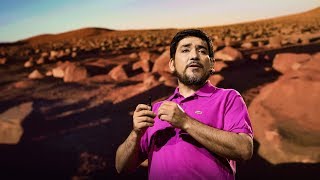This is a picture of a sunset on Mars taken by NASA's Curiosity rover in 2013.
这张是火星上的日落照片,由美国国家航空航天局“好奇号”于2013年拍摄的。
Mars is a very cold planet, flooded with high levels of UV radiation and extremely dry.
火星是个非常寒冷的星球,受强烈紫外线覆盖,而且极为干燥。
In fact, Mars is considered to be too dry for life as we know it.
事实上,我们认为火星太干燥,没有生物存在。
I'm an astrobiologist.
我是天体生物学家。
I try to understand the origin of life on Earth and the possibilities of finding life elsewhere in the universe.
我尝试去了解地球上生物的起源,以及在宇宙中其他地方找寻到生物的可能性。
People sometimes ask me, how can you be an astrobiologist if you don't have your own spaceship?
有时候,大家会问我,如果你没有自己的宇宙飞船,又怎算是天体生物学家呢?
Well, what I do is that I study life in those environments on Earth that most closely resemble other interesting places in the universe.
其实,我专注在地球寻找与其他星球相似的环境,并研究该自然环境的生物。
All life on Earth requires water, so in my case I focus on the intimate relationship between water and life
地球上所有生物赖以水为生,因此我专于研究水和生命密切的关系,
in order to understand if we could find life in a planet as dry as Mars.
从而去了解我们能否在像火星般干旱的星球找到生物。
But since I do not have the 2.5 billion dollars to send my own robot to Mars,
由于我没有25亿美元资金把自己的机器人送到火星,
I study the most Martian place on Earth, the Atacama Desert.
因此研究地球上与火星最似的地方:阿他加马沙漠。
Located in northern Chile, it is the oldest and driest desert on Earth.
它位于智利北部,是地球上最古老和干旱的沙漠。
To give you an idea of how dry it is, consider here in Vancouver it rains over 1,000 millimeters of rain every year.
给你一个例子,就明白有多干燥。试想,温哥华年降雨量超过1000毫米。
In the Atacama, there are places with no reported rains in the last 400 years.
过去四百年,阿他加马有些地方从来没有降雨记录。
How do I know this? Well, because I was born and raised in the Atacama.
为什么我会知道?因为我在阿他加马出生和长大。
So I had a unique advantage when I started studying this desert.
因此,当我对沙漠展开研究时,有得天独厚的优势。
So let me tell you guys a few fantastic examples he has found on how life has adapted to live with almost no water at all.
就让我向各位分享他所找到的惊人发现,即生物在干旱地方如何能完全适应。
One of my first findings was in the entrance of a cave facing the Pacific Ocean.
我的早期发现之一是在某个洞穴的入口,该洞穴面向太平洋。
In this place, we reported a new type of microalgae that grew only on top of the spiderwebs that covered the cave entrance.
在这里,我们发现一类新型微藻,只长在覆盖洞穴入口的蜘蛛网上。
Have you ever seen a spiderweb early in the morning?
你有否在大清早见过蜘蛛网?
It's covered with dew, so this microalgae learned that in order to carry photosynthesis in the coast of the driest desert on Earth,
蜘蛛网被露水覆盖,因此微藻为了在地球上最干旱的沙漠进行光合作用,
they could use the spiderwebs.
学会借用蜘蛛网。

So here they may access the water from the fogs that regularly cover these areas in the morning.
微藻透过每清早落在蜘蛛网上的露水吸取水分。
In another cave, we found a different type of microalgae.
我们在另一个洞穴发现别种微藻,
This one is able to use ocean mist as a source of water, and strikingly lives in the very bottom of a cave,
这种微藻以海洋带来的雾气为水源,而且很惊人地生长于洞穴底处,
so it has adapted to live with less than 0.1 percent of the amount of light that regular plants need.
因此它习惯生存在光源只有普通植物所需光源0.1%的地方。
These type of findings suggest to me that on Mars, we may find even photosynthetic life inside caves. And by the way, that's me.
这些研究结果意味着在火星也可能在洞穴找到植物。顺带一提,这个是我。
Now, for almost 15 years this region of Yungay, discovered by NASA,
美国国家航空航天局发现位于秘鲁永盖的这个区域至今已有15年,
was thought to be the driest place of this desert, but I knew that it was not. How?
原被视为这片沙漠中最干旱的地方。但据我所知,这里并不最为干旱。我怎么会知道?
You already know the answer. Because I was born and raised in this desert.
你已经知道答案:因为我在这片沙漠出生和成长。
So I remembered that I usually see fogs in Yungay, so after setting sensors in a number of places,
我记得经常在永盖看到雾。后来我在别的地方设置传感器,
where I remember never seeing fogs or clouds, I reported four other sites much drier than Yungay,
因为我从未在那里见过雾和云,我发现四个比永盖还要干旱的地方。
with this one, María Elena South, being the truly driest place on Earth, as dry as Mars,
这里,玛莉亚埃琳娜南区,是地球上真正最干旱的地方,跟火星一样干旱,
and amazingly, just a 15-minute ride from the small mining town where I was born.
惊喜的是,这里距离我出生的煤矿小镇只有十五分钟路程。
Now, in this search, we were trying to actually find the dry limit for life on Earth,
在研究中,我们尝试找出地球上生物耐旱的极限。
a place so dry that nothing was able to survive in it.
在这个干旱到寸草不生的地方。
But even here, well hidden underground, we found a number of different microorganisms,
尽管如此,我们在地底发现到多种微生物,
which suggested to me that similarly dry places, like Mars, may be inhabited.
这个结果提醒我,即使干旱如火星的地方也可能住着生物。
We even have some preliminary evidences that these microorganisms may still be active in the desiccated state,
我们甚至已有初步证据证明微生物在干旱情况下仍然很活跃,
like walking mummies all around us, and that they may be using UV radiation as a source of energy.
就像木乃伊在我们身边走动一样,微藻有可能以紫外线作为能源。
If confirmed, this would have a huge impact on our definition of life, on how we look for life elsewhere in the universe.
如果得到证实,这将改变我们对生物的定义,以及在其他星球寻找生物的看法。
Due to its clear skies, by 2020, 60 percent of the biggest telescopes on Earth will be located in the Atacama,
由于这里天气晴朗,到了2020年,地球上百分六十的大型望远镜将会设置于阿他加马。
and while everyone else will be looking among the stars to answer the question, "Are we alone?"
那时每个人会在望着星星时发问:“地球是唯一有生物的地方吗?”
I will be looking down to the ground searching for this same answer in my own backyard. Thank you.
我会在家中后院,望着地下,寻找同一答案。谢谢。


